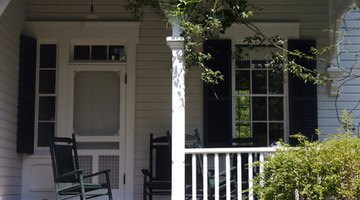How to Insulate a Baseboard
Proper insulation is the best way to keep a home energy-efficient. Unfortunately, no insulation is perfect and cold air can find its way into the room through imperfectly sealed doors and windows and gaps behind the baseboard. Doors and windows can be sealed with caulk, but gaps between the wall and floor are usually too big for this. Fortunately, there is an easy solution.

Step 1
Remove the baseboards one at a time. Run a utility knife along the top of the trim to help separate it from the drywall. Work a putty knife behind the trim at the center. Hook a pry bar behind the board and gently free up the closest nail. Continue along the board, nail, by nail, until you can pull the entire board away from the wall. Repeat until all the baseboards have been removed.
Step 2
Pull old nails out the back of the baseboards with nippers and set the boards aside.
Step 3
Apply a length of painter's masking tape about 4 to 6 inches wide to the floor and the wall where you will spray insulation.
Step 4
Shake a can of spray foam insulation thoroughly and push on the rubber application tube that came with the can. Wear rubber gloves.
Step 5
Hold the can upright and insert the nozzle of the tube into the gap and begin spraying. Move along the wall as you spray, filling the gap no more than half full. The foam will expand as it dries, filling the gap completely and bulging out a bit. Let the foam dry completely.
Step 6
Cut the foam flush to the wall, using a utility knife. Re-attach the baseboards.
References
Tips
- When you nail baseboards to the wall, be sure the nails sink into wood, and not just the drywall. If you want the nail to disappear, use a nail punch to sink the nail head and apply wood putty over the hole.
Warnings
- Spray foam insulation is extremely sticky when wet and next to impossible to remove when dry. Wear old, discardable clothes and rubber gloves. Keep a rag handy and wipe drips immediately with acetone or lacquer thinner. Wrap the rag around the nozzle when you are not spraying because it will drip, even if you think it won't.
Writer Bio
Chris Deziel has a bachelor's degree in physics and a master's degree in humanities. Besides having an abiding interest in popular science, Deziel has been active in the building and home design trades since 1975. As a landscape builder, he helped establish two gardening companies.
Photo Credits
- home sweet home image by David Dorner from Fotolia.com
More Articles


